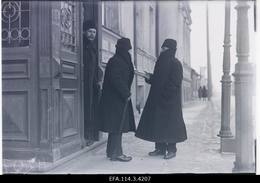10 facts about how the Tartu Peace Treaty came about
One of the most striking stories about the birth of the Tartu Peace is how young soldiers were ordered to march in a circle around the city in the winter of 1919/1920. It probably started when the border negotiations failed to make any progress. In 1919, the commander of the 2nd Division, Colonel Viktor Puskar, ordered the Tartu schoolchildren's battalion to march around the city in such a way that it would repeatedly pass through both Aia (now Vanemuine) Street near the conference building and Veski Street, where the Russian delegation was staying.
One of the most striking stories is how the young soldiers were made to march in a circle around the city, says historian Ago Pajur. “It probably started when the border negotiations didn’t make any progress. The parties stuck to their demands,” he adds. The Estonian men wanted to show their neighbors that we still had an army. To intimidate them a little with their size or something. So the commander of the 2nd Division, Colonel Viktor Puskar, ordered the Tartu schoolchildren’s battalion to march around the city in such a way that it would repeatedly pass through Aia (now Vanemuine) Street by the conference building and Veski Street, where the Russian delegation was staying. “The battalions at that time had 700–800 men. Rifles on their shoulders, some with machine guns under their arms, an orchestra playing in front of them – it must have been quite a magnificent sight,” says Pajur. The young men marched like that for three hours.
10 facts about how the Tartu Peace was born. Õhtuleht, 02.02.2020. https://ajalugu.ohtuleht.ee/364980/10-seika-kuidas-sundis-tartu-rah
Related objects
Site of the Treaty of Tartu
This building is situated at Vanemuise 35 in the centre of Tartu. It is of great importance in the history of Estonia: it was here that the Tartu Peace Treaty between Estonia and Russia was signed, ending the War of Independence.
The building was constructed in 1859 as the residence of one Baron Nolcken before being purchased by the Russian Ministry of War in the late 19th century. Among other things, the building accommodated the Red Army Latvian Riflemen. Following the declaration of independence it was acquired by the Supreme Court of Estonia, and the Treaty of Tartu was signed there on 2 February 1920. During the German occupation the building housed the local Sicherheitsdienst (Security Service) and Sicherheitspolizei (Security Police). The building was badly damaged during World War II, with only the outer walls and vaulted cellar surviving. After the war it was restored and turned into a vocational school; today an upper secondary school operates there.
The façade is adorned with a memorial tablet dedicated to the Treaty of Tartu in both Estonian and Russian.





